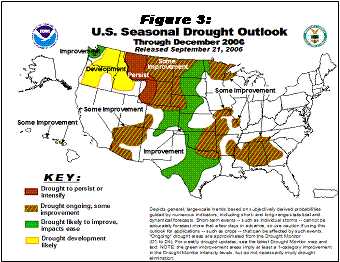Click here for the Acrobat version of this publication.
AG-ECO NEWS
Vol. 22, Issue 32, October 11, 2006
Jose G. Peña
Extension Economist-Management
The Continuing Severe Drought May Delay Livestock Re-stocking Into Late 2007
The rain in mid-September and the recent showers provided some hope, but the southwest Texas region remains very dry and forecasts of rain do not appear very optimistic. It will take years for pastures and ranges to recover. Some may not recover without major range improvements. Re-stocking may have to be delayed until late 2007.
As measured in Uvalde, which probably reflects the relative rainfall condition for a large portion of Texas, rain in September ended at less than 70% of long term average, rain so far in October is below average, year-to-date cumulative rainfall remains at about 31 percent of the long term average and the last 18 month period from, April ’05-to-October 10, 2006, was the driest period on record. (See Figure 1).

Rainfall during this 18 month period averaged 62 percent below the long term average. Yes, that is about 62 percent less rainfall than the average amount which has created the ecological environment which is dependent on that rain. This drastic reduction of rainfall extends through at least four growing cycles (spring ‘05, fall ‘05, spring ‘06, fall ‘06).
Forage availability is too short to sustain minimum livestock stocking rates without serious effect on wildlife. Even if it rains now, there is not sufficient time left, before the average first killing frost, to produce enough over-wintering forage. Under normal rainfall conditions, winter grasses only provide about 15 percent of typical annual production. And, it will be difficult to produce the typical spring forage even if we get normal winter/spring rainfall since the soil profile is completely dry.
In the final analysis, the real effect of any drought is its influence on vegetation and the vegetation’s capability to recover. To recover, the vegetation’s seed or rootstock must survive a drought. Seed/rootstock must be protected during periods of reduced rainfall, such as severely reducing grazing pressure. Recovery also requires abundant and timely rainfall. In addition to continued reduced stocking rates, significantly above average rainfall will be needed for several years to recover from the current drought. This appears unlikely, but even with above average rainfall it may be difficult to recover. Weather forecasters appear pessimistic about rain in the short term. (See Figure 2 and 3).


Snout Butterfly/Desert Termite
The recent infestations of snout butterflies and the increased incidence of desert termites appears directly associated with the drought and could have some implications.
Snout butterflies typically forage on spiny hackberry plants. Populations are kept in check by beneficial insects and diseases. According to Dr. Noel Troxclair, Assistant Professor and Extension Entomologist, the drought and record high temperatures in August significantly reduced the density of beneficial organisms which reduce snout butterfly larval numbers. Reduced environmental pressures triggered the infestation. Intermittent rain in September caused new vegetative growth. Higher densities of snout butterflies laid eggs, creating subsequent waves of snout butterfly infestations. Similarly, we can expect higher densities of fall and true armyworms this fall/winter on the grass crops that are present. These worms will be attracted to succulent, green plants and could cause serious defoliation of such fields, especially irrigated ones.
Desert termites forage on dead or dormant grasses. Increased swarming often follows summer rain, but densities are kept in balance as mid-summer temperatures rise. The termites generally disappear by early fall. The current drought and over-grazing this spring/summer left very little vegetative cover. In addition, field termites destroyed a lot of the dormant or dead vegetative cover. Record high temperatures this past summer on bare soil probably severely weakened the rootstock. It may be difficult for grasses to recover, even if we have above average rainfall.
